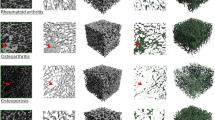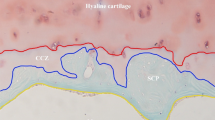Abstract
Objective. To determine if there is a change in bone density in osteoarthritic femoral heads removed at joint replacement surgery and to compare bone density in different arthropathies.
Materials and methods. All femoral heads removed at joint replacement surgery at St. Michael's Hospital were examined in the Laboratory of Bone and Joint Pathology, intact as received, following sectioning in the coronal and sagittal planes by fine-detail, low-energy radiology with high-resolution, single-emulsion film. Sections were submitted for histomorphology and the study was undertaken to determine quantitatively, with the computer-assisted system, the bone density of the femoral heads.
Results. Values in non-weight-bearing areas of cases of rheumatoid arthritis, fracture, and some zones of osteoarthritis were below normal values. The interesting feature was that the cortex at the calcar of the neck tended to show a greater porosity than expected for cortical bone in all cases. There was difference in density, with statistical significance in comparing weight-bearing zones of osteoarthritis versus fracture, and in osteonecrosis versus fracture, in both weight-bearing and non-weight-bearing zones. There was a strong statistically significant difference in P values between the weight-bearing and non-weight-bearing areas of patients with osteoarthritis and a relatively nonsignificant difference in patients with rheumatoid arthritis. There also was a statistically significant difference between weight-bearing and non-weight-bearing areas in the patients with fractures.
Conclusion. The study demonstrated the static morphologic and morphometric variables in surgically resected femoral heads at the time of total hip arthroplasty. Obviously, this data is not a measure of outcome but must be regarded as a potential indicator of implant/host bone relationship with morphologic and morphometric implications. One can only speculate that assessment of bone density/porosity can be a predictor of long-term outcome.
Résumé.
Les auteurs ont étudié la densité osseuse des têtes fémorales ôtées lors d'arthroplasties totales de hanches. Ils arrivent à la conclusion qu'il existe une grande variation de la densité osseuse d'un cas à l'autre. Cette variablité ne constitue pas à leurs yeux un facteur pronostique des arthroplasties, mais doit être considérée comme un indicateur potentiel des relations entre l'os hôte et l'implant avec des implications morphométriques et morphologiques. On peut seulement supposer que l'évaluation de la densité et de la porosité osseuse peut être un prédicateur du résultat à long terme.
Similar content being viewed by others
Author information
Authors and Affiliations
Additional information
Electronic Publication
Rights and permissions
About this article
Cite this article
Zhao, J., Fornasier, V.L., Chen, D. et al. Bone density in osteoarthritic femoral heads removed at joint replacement surgery – quantitative assessment by histologic and fine-detail radiographic analysis. Eur J Orthop Surg Traumatol 12, 69–74 (2002). https://doi.org/10.1007/s00590-002-0026-5
Received:
Accepted:
Published:
Issue Date:
DOI: https://doi.org/10.1007/s00590-002-0026-5




